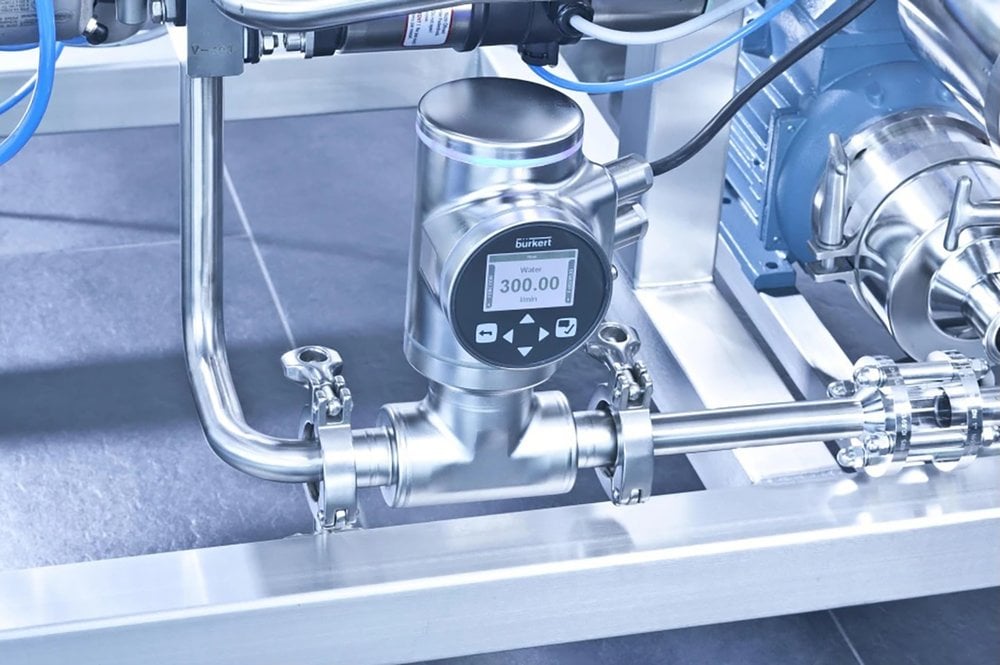www.industry-asia-pacific.com
13
'19
Written on Modified on
Taking on the challenges of flow measurement in the food and beverage sector
Manufacturers in the food and beverage industry have two main priorities: product quality and hygiene.

Flow measurement is a vital part of food and drink manufacturing, from filling vessels to measuring ingredients and controlling cleaning processes, the humble flowmeter performs many tasks. Flowmeters in general come in many shapes and sizes, but for applications in the food and beverage sector, only a few of these are suitable to ensure hygiene standards and precision are maintained.
Optimised hygiene
Clean in Place (CIP) procedures often use demineralised water as well as expensive chemicals to remove scale, bacteria and debris from process vessels and pipework. However, using a flowmeter that relies on the conductive properties of water, such as a magmeter, for this application can be unreliable because applications using de-ionised water or containing entrained bubbles do not provide reliable readings.
One solution to these issues is to install a Coriolis flowmeter, but the expense of this type of flowmeter makes it an unlikely candidate because the level of accuracy afforded by the Coriolis is not required in this application. In addition, large, cast devices can act as a heat sink, drawing temperature away from a heat sensitive product, such as chocolate, meaning that additional energy has to be used to ensure the product remains at the correct temperature throughout the process.
This heat transfer issue also comes into play after a CIP process, where the pipework will be heated by the cleaning procedure and should be returned to normal operating temperature before the manufacturing process can resume. The time for this to happen can be considerably extended when large heat sinks are included in the pipework.
Go with the flow
In some cases, plant operators may want to measure liquid flow in both directions, but many flowmeter designs will not permit this, which means that two pieces of equipment are required, adding to installation and maintenance costs. In fact, almost every flowmeter design has some drawbacks.
Ultrasonic devices using the Doppler Effect need particulate material or bubbles to reflect the signal, making them ineffective with pure fluids. Conversely, those that use transit time to measure flow can only work with pure fluids. A combination of the two can be employed, but again there are additional cost implications as well as issues with reduced accuracy in low flow conditions.
Advanced technology
In response to a growing need for a flowmeter that could overcome many of these short-comings, Bürkert has developed a ground-breaking solution that uses surface acoustic wave (SAW) technology. The physical design of this revolutionary flow measurement system means that there is no direct contact of any sensor components with the fluid, making it ideal for hygienic applications.
Furthermore, it can be manufactured to the same surface finish as the rest of the pipeline, meaning that, in terms of hygiene, cleaning and flow conditions, there is no difference to any other piece of straight pipe.
FLOWave measures flow in both directions, not possible with magflow. If a process cannot withstand flow in both directions, there needs to be some sort of signal that warns of flow moving in the wrong direction. The ability to measure in both directions also means that the flow can be aggregated and the total flow can be calculated.
Additional benefits
Flow measurement is just one of the capabilities of this equipment. Significant benefits can be achieved using the density factor and the acoustic transmission factor to determine the exact point when one fluid has been replaced by another or when pipework has become fouled for example.
During a product changeover within the same process line or as part of the cleaning process, it is common for a time-based control system to be used to ensure that new product has started to flow and all of the initial product has gone.
This means that a certain amount of the new product or the cleaning fluid will be wasted before production recommences. A better solution would be to use a flow measurement system that could also determine the density factor of the fluid and provide control signals for the wider manufacturing process. This would minimise waste and ensure the cleaning process was complete before any foodstuffs re-entered the pipework.
Precision data
In fact, the accuracy of Bürkert’s FLOWave is such that it can determine the difference between a standard carbonated soft drink and its sugar-free alternative. This can be implemented in many different types of production facilities such as breweries, dairies, drinks manufacturing and confectionary.
The acoustic transmission factor can be tuned to such a degree that it can flag up when the pipework is becoming fouled up. A build-up of scale or even product, sauces, chocolate, caramel or liquid cheese for example, all have the potential to build-up on the pipe wall and still remain after the CIP process.
Understanding the level of debris inside the pipework enables the plant operator to make an informed decision on the best time to use a mechanical pipe cleaning process. This descaling or ‘pigging’ can be performed without removing the FLOWave because its internal design is the same as the rest of the process pipework.
Ultimately, implementing technology can have a number of benefits to an existing manufacturing facility, even more so when it is designed to integrate easily and work with the existing process control infrastructure. For the food and beverage sector, improved control systems help to enhance product quality and consistency. Putting in place quality checks and the latest process sensors will go a long way to delivering this end goal.
www.burkert.com

